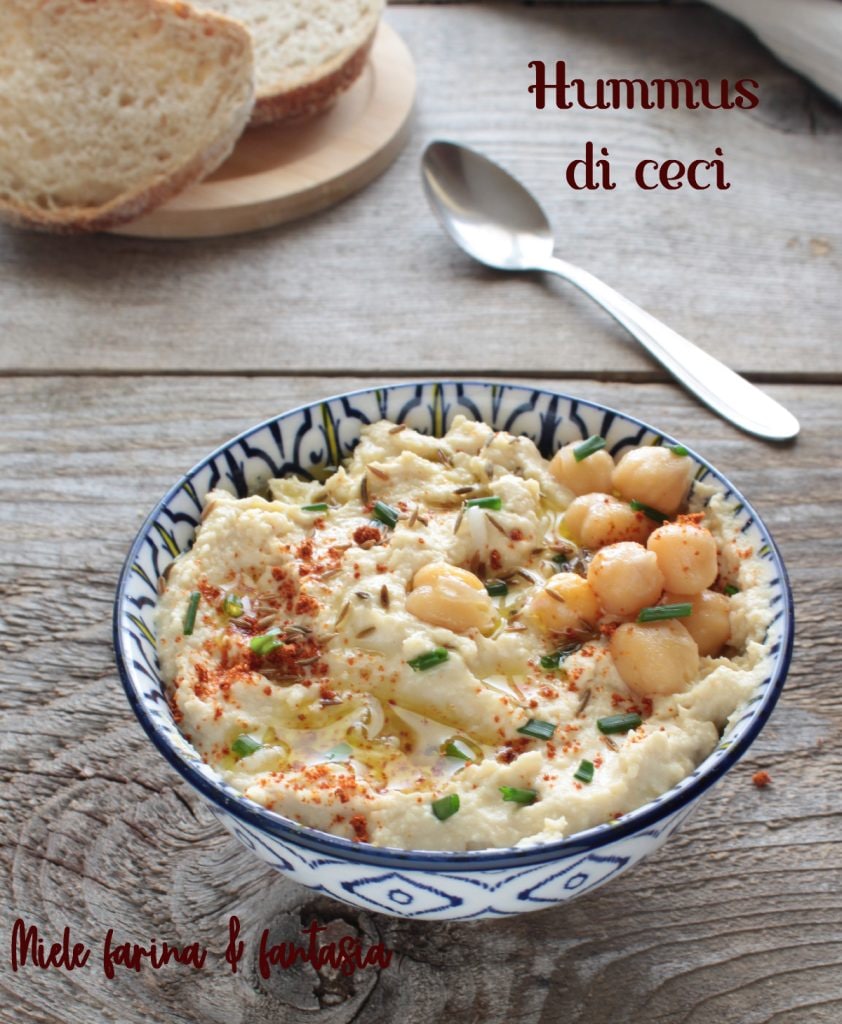If you like chickpeas as much as I do, you absolutely must try hummus, a completely vegetarian sauce, with a more or less dense consistency, spicy, with a unique fragrance and flavor, fabulous, delicious, excellent. Am I exaggerating? Maybe, but it’s truly exquisite whether eaten on its own or paired with pasta, rice, meat, fish, cheese, and fried foods (instead of mayonnaise or ketchup). It’s prepared quite quickly if you already have the chickpeas and tahini ready (besides chickpeas, it’s the other essential ingredient for making hummus and can also be homemade easily and quickly). Chickpea hummus can be prepared in all seasons; it’s very versatile and does not contain gluten, lactose, milk proteins, or eggs. This is hummus as we like it.
Bon appetit

- Difficulty: Very easy
- Cost: Very inexpensive
- Rest time: 15 Minutes
- Preparation time: 15 Minutes
- Cooking time: 7 Minutes
- Portions: 6
- Cuisine: Italian
- Seasonality: All seasons
Ingredients
- 14 oz cooked chickpeas
- 1/2 cup tahini paste
- 1 clove garlic
- 1/4 tsp cumin
- to taste sweet paprika
- to taste fresh chopped chives (optional)
- to taste fine salt
- to taste extra virgin olive oil
- 3 tbsps lemon juice
- 7 oz white sesame seeds
- to taste extra virgin olive oil (or sesame oil)
- 5 tbsps lemon juice
Tools
- 1 Food processor
Steps
To make hummus, we can use either chickpeas cooked by ourselves or canned ones.
In both cases, the chickpeas must be thoroughly drained from the cooking or preservation liquid (personally, I take an extra step with canned chickpeas, rinsing them under running water after draining).
Let’s start by making the tahini paste.
Pour the white sesame seeds into a large non-stick pan and toast them for a few minutes over low heat on the smallest burner (I usually take 7/8 minutes), stirring them occasionally with a metal spoon to prevent burning. The color of the toasted seeds doesn’t change much compared to the untoasted ones.
As soon as the sesame aroma becomes noticeable and the seeds start sticking to the metal spoon, turn off the heat and immediately transfer the seeds to the bowl of the blender (or an immersion blender suitable for small quantities) and let them cool for 5/7 minutes.
After this time, pour three or four heaping tablespoons of oil (I use extra virgin, but many recipes call for sesame oil for a more pronounced flavor in the tahini paste) and start blending until you get a semi-dense, pasty, and especially smooth mixture. Add more oil as needed, until reaching the desired consistency.
If you only need the tahini paste for making hummus, you can adjust its consistency by adding lemon juice at this stage (without having to add it later during hummus preparation), thus avoiding using too much oil.
Now let’s move on to the actual preparation of the hummus from chickpeas
Transfer the cooked and drained chickpeas to a food processor, add the tahini paste and all other ingredients (except spices and oil, which we will add gradually until reaching a thick, smooth, and velvety cream-like consistency both visually and on the palate). Preferably, insert the garlic without the inner sprout.
Blend until you obtain a smooth mixture, without chickpea skins, dense but not hard (in this case just add a few tablespoons of hot water to the mixture) nor liquid (in this case, just add a bit more chickpeas).
Taste and adjust salt and oil if necessary.
Finally, add a level quarter teaspoon of cumin, 5 strands of chopped chives, and half a teaspoon of sweet paprika, mix with a spoon and serve, adding another drizzle of oil on the hummus. The hummus can be stored in a well-sealed glass jar in the fridge for two or three days.
Spices can also be blended together with the other ingredients; I prefer to add them later to avoid overpowering all the other flavors and to allow other diners to add the ones they prefer most.
Cumin can be replaced with freshly chopped parsley.

